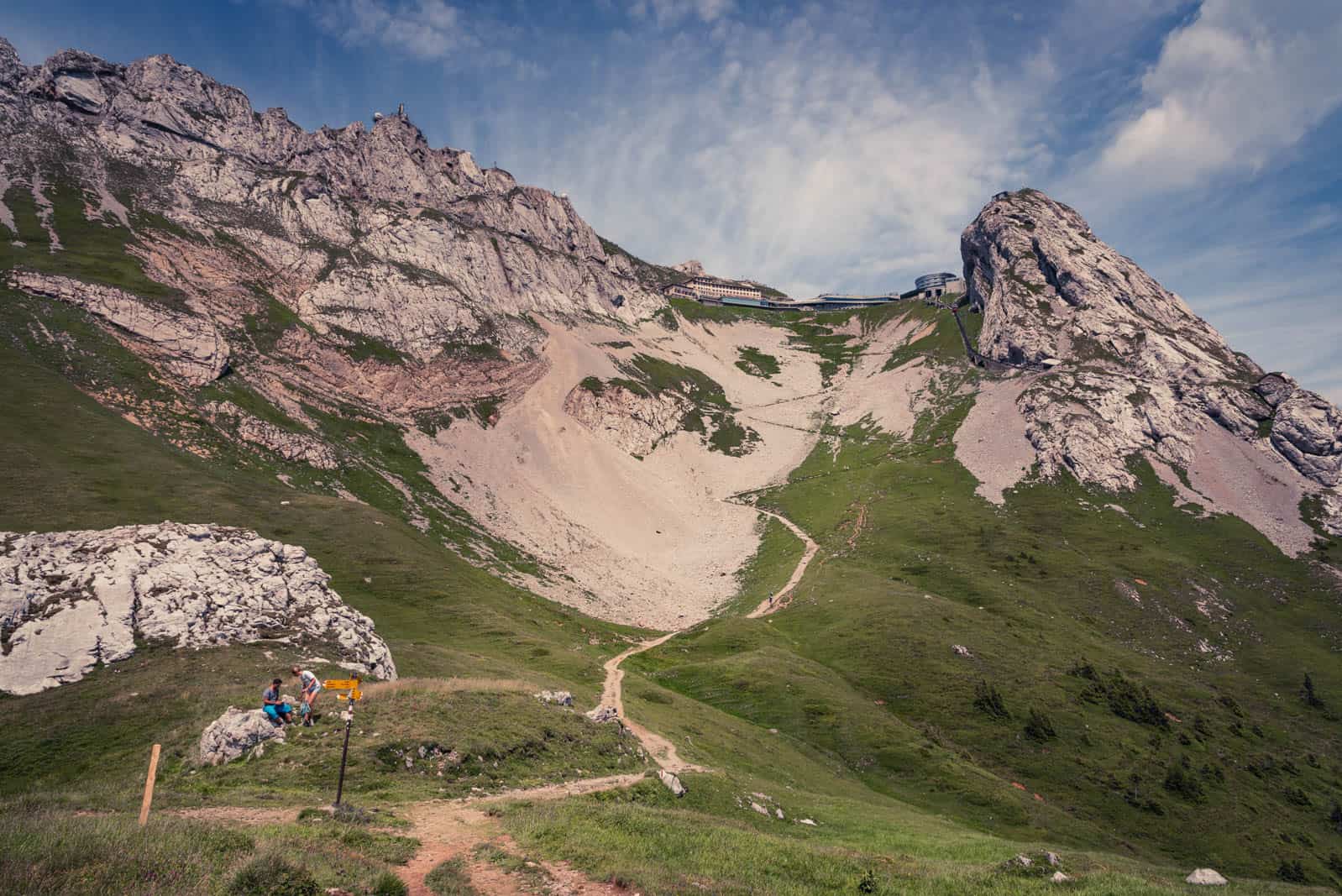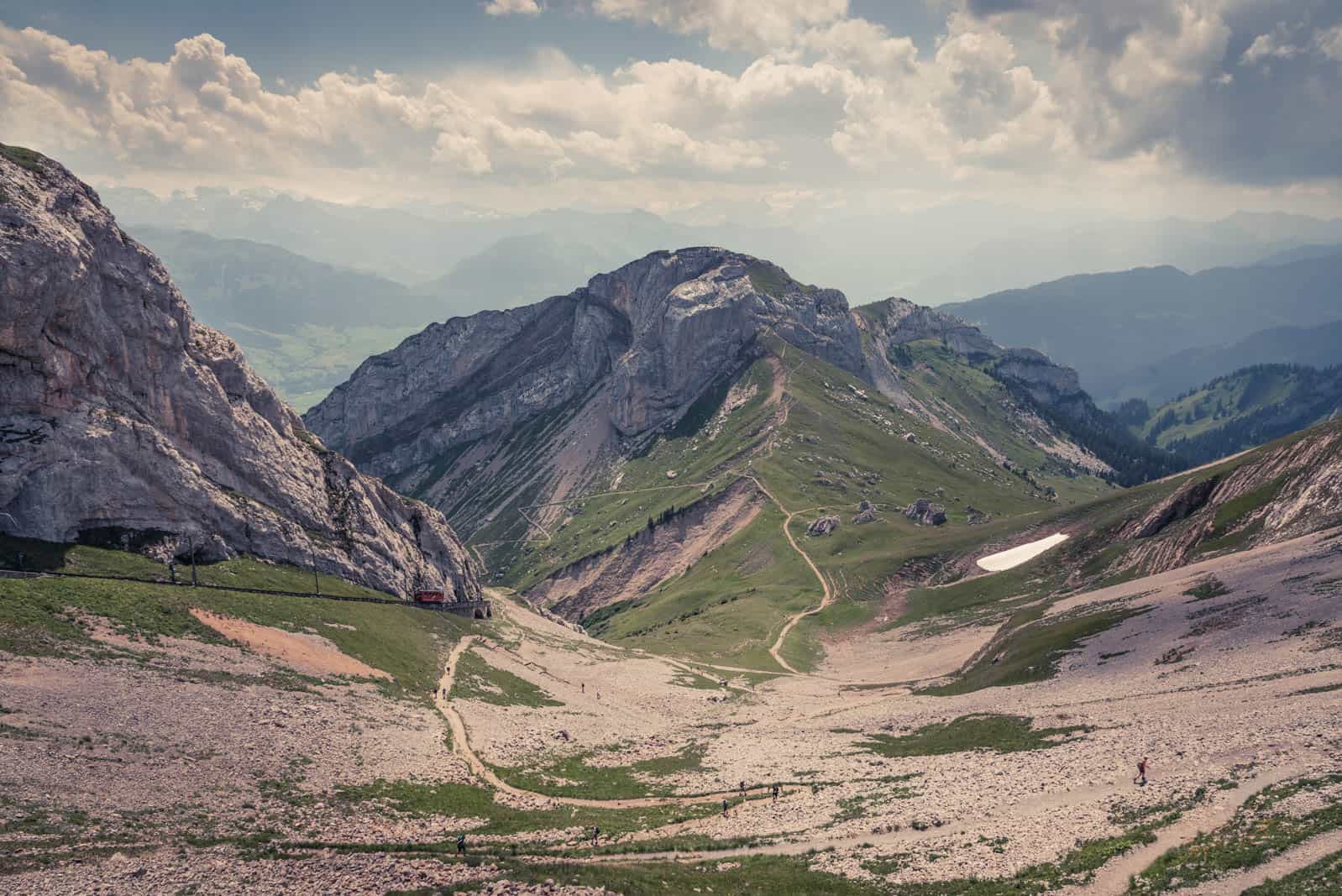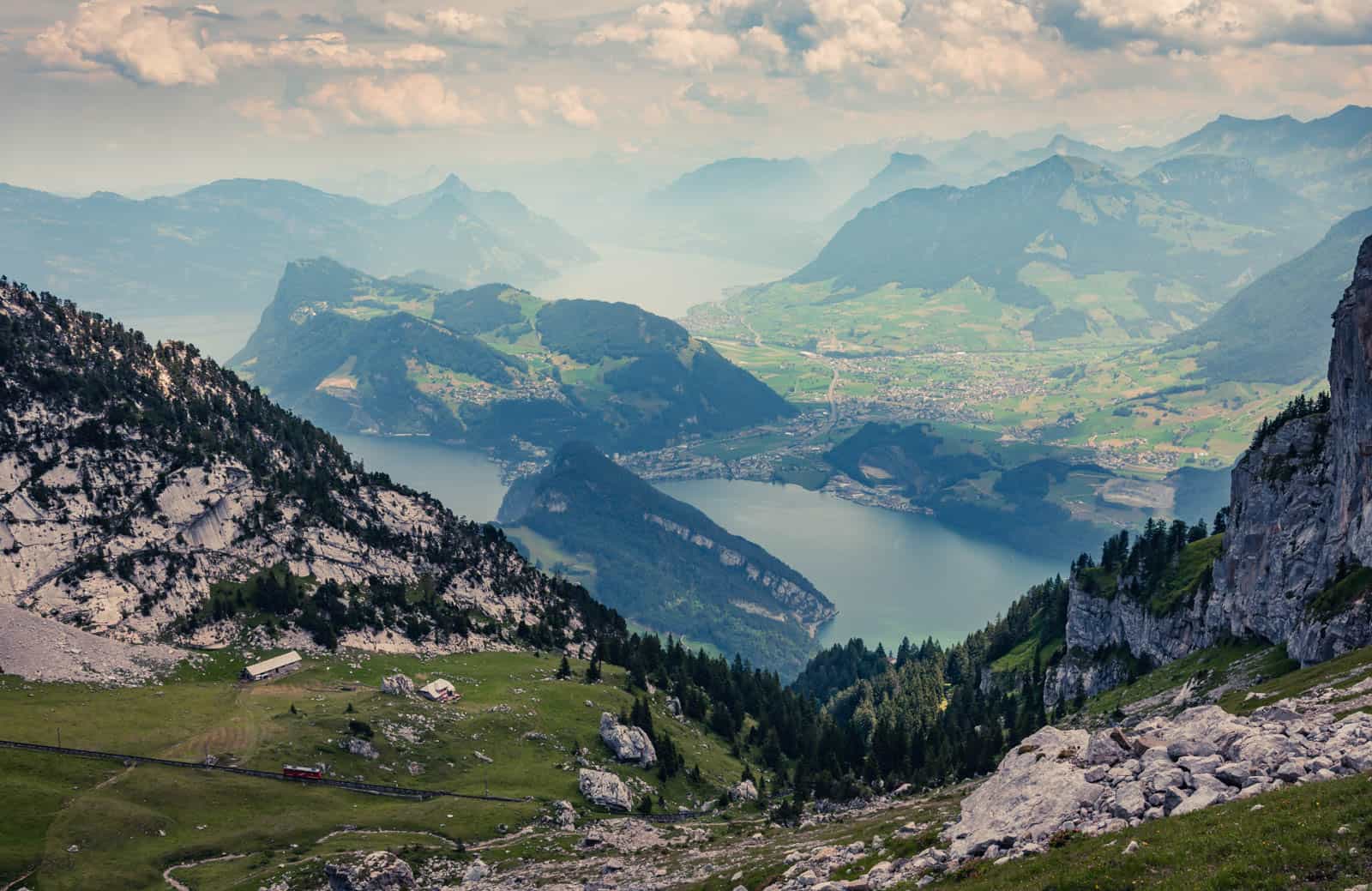Hike | Lucerne | Switzerland
Hike Pilatus - Mountain of Dragons
Text | Anninka Kraus
Photography | Tobias Kraus

Switzerland
Pilatus is one of Switzerland’s best day hikes. On a clear day, you can see the famous Eiger, Mönch, and Jungfrau in the Bernes Alps to the southwest, and even the Black Forest in Southern Germany to the north from the summit.
Also, there are numerous stories associated with this mountain. Fortunately not the sort of stories I hate, gruesome ones, like German author Heinrich Hoffman’s immensely popular fairytale ‘Struwwelpeter’ that was read to me as a child. Even then I wondered, who in his right mind cuts thumbs off children, burns and starves them to death – even if only in text and graphic detail – and calls this misguided attempt to teach children life lessons “Merry Stories and Funny Pictures”.
In this case, it’s the sort of story – legends – where history embellished to sound like fantasy reads like a fairytale, adding context and depth to a location, hike, or geological feature. The two peaks that flank either side of the Kulm summit of Mount Pilatus, Oberhaupt at 2106 m and Esel at 2118 m, is such an example.
Once you know the legend of the dragons, these two peaks that rise above Lucerne will look just like a dragon’s horns, especially when at twilight the mountain flattens to a black unidimensional paper cutting silhouette against the bluish night sky giving the stark outline of two horns.
Once upon a time, on the banks of the Reuss River, the Benedictine monastery of St. Leodegar (Luciaria) was founded.
The town that developed around the monastery in the middle ages derived its name from it, Lucerne, and through various battles with the Habsburg and Napoleonic armies, gained in importance throughout the centuries. The medieval Old Town may well inspire a Disney movie one day: 14th-century town walls with nine watchtowers stand guard over two wooden bridges spanning the Reuss river, Kappelbrücke und Spreuerbrücke dating from 1333 and 1408 respectively, and baroque-style townhouses stand lavishly adorned with frescoes.
Though lacking a castle, Château Gütsch hotel graciously accepts this role, a brilliant white miniature version of Neuschwanstein Castle with turrets, gables, and crenellations.
Architecture aside, this beautiful city is cast as the location of legend, with tellings of dragons that in medieval times were said to live on Mount Pilatus, and when infuriated swooped down to rage on the city. For fear of provoking these creatures and invoking terrible storms and floods, climbing Pilatus was strictly forbidden for centuries and the ban not lifted until 1594 when luckily, the Swiss love for hiking prevailed.
In the mid 19th century Hotel Bellevue opened. Perched on the Mount Pilatus summit, it quickly gained popularity and went on to host no other than the British monarch Queen Victoria and her entourage some years later. I imagine it was an arduous journey at the time, but the Swiss are excellent engineers, keen to share their love for majestic summits, and make their mountaintops accessible to everyone. They accomplished an incredible feat in 1889 with the construction of the world’s steepest cogwheel train, running between Alpnachstad and Pilatus Kulm. With a gradient of 48% it is still unsurpassed.
Nowadays, you can either take that cogwheel train for a half-hour ride to the top via Fräkmüntegg or the gondola and cable car up the north face of Mount Pilatus starting from Kriens. You can also combine all three with a boat cruise between Lucerne and Alpnachstad on the “Golden round trip”. I believe, the most rewarding way to reach the summit however is still by foot on a hike that takes you from Kriens to Alpnachstad via Pilatus Kulm where you’ll brave both sides of the mountain with sprawling views to the north and south.
On a hot weekend mid-July, we started off through the outskirts of Kriens, past the lower cable car station, to a clearing in the woods at Krienseregg, where you can find a phenomenal playground for kids and fantastic views of Pilatus. We then continued on the trail for another 50min to the Fräkmüntegg upper cable car station at 1416 m, an adventure activity destination in its own right: There is a 1.35km toboggan run, the longest in the country, as well as Central Switzerland’s largest rope parkour park. I don’t care much for either – one is too fast and the other too high up in the trees for me – but every time I walk past the green tents floating in midair, stretched between trees, I long to spend a night here. You can book a night’s stay in a tree tent online and watch dawn break over Central Switzerland.
Past Fräkmüntegg, grass- and woodlands gradually transitioned into sheer rock as we climbed with no tree cover to Klimsenhorn saddle. Perched on this skinny ridgeline, a chapel squats just below the north face of Pilatus.
Viewed from afar, it gives the impression of a precarious balancing act, but up close there is actually a wide stretch of grassland in front of the chapel which is popular with locals for bivouacking. The last stretch from Klimsenhorn on hairpin switchbacks up a steep scree slope was demanding but less jarring than the sudden transition from trail to the summit at 2073 m which features a hotel, restaurant, visitor’s centre, tourist shop, and large viewing platform.
Like Mount Rigi it faces a perpetual onslaught of tourists year-round. Since most visitors do very little walking, the crowds are quickly left behind once you’re back on the trail.
During this excursion we skipped detours to the three highest peaks of the massif -Esel, Oberhaupt and Tomlishorn at 2128 m – all three less than half an hour’s walk from Kulm. However, I can highly recommend them from previous hikes, the views outstanding.
On the long descent on tired legs towards the lakeshore, we became engulfed by the most quintessentially Swiss countryside – cows, seemingly oblivious to the incessant ringing from the bells around their necks, nibbled on dandelions as hikers walked past down meadows sloping gently towards the lake that was dotted with sailboats and stretched deep into the valley.
At length, the track again disappeared into the woods. Though the heat was broken by the tree canopy, the smell of sunbaked pine needles and leaves grew strong, and rays of the sun still burst through the foliage to the forest floor dappling it in light. When we emerged from the woods, the lakeshore was close, but we realized we’d timed it badly to catch a ferry back to Lucerne.
We added an hour’s detour to Alpnachdorf to our hike to arrive in time for the 5:37 pm ferry, but if you want to skip this detour, follow in the direction of Grossrüti where the trail reaches a junction just past Ämsigen.
From Alpnachstad, you can return to Lucerne by boat or local train. We take the boat every time – it runs less often and takes longer, but watching the beautiful lakeside scenery float past to the backdrop of the mountain you just climbed is bliss. The upper deck is accessible to first class passengers only, the views from this elevated position however are worth the upgrade.
related.
Hike Mt Rigi on the Mark Twain Trail
Guide to hiking the famous Tour du Mont Blanc through Italy, France and Switzerland
Hike Switzerland’s most famous ridge line: Augstmatthorn














On the descend, down meadows sloping gently towards the lake that was dotted with sailboats and stretched deep into the valley, we became engulfed by the most quintessentially Swiss countryside.
what to expect.
360º panoramic views of Central Switzerland towards Eiger, Mönch, and Jungfrau in the Bernes Alps
Climb 1,700 vertical meters on well maintained and clearly marked trails to the top of Pilatus, Mountain of Dragons, featuring two peaks that look like a dragon’s horns
The world’s steepest cogwheel railway with a gradient of 48%, running since 1889
Mount Pilatus golden round trip is an alternative for non-hikers, taking you from Lucerne via panorama gondola, aerial cableway, and cogwheel railway across Mount Pilatus to Alpnachstad, and back by boat (the loop runs in both directions)
Lucerne | Switzerland
Hike | Point-to-point trail (loop incl. public transport) | 6 hours
track details.
What & When: One-way hike in Central Switzerland, close to Lucerne. From late spring to mid-autumn the trail should be free of snow and ice, but if you’re still unsure about weather conditions on the summit, check these webcams. If you’re visiting Lucerne in winter, Pilatus offers great snowshoe hiking, a 3km and 4.8km sledge run between Fräkmüntegg and Kriens, and some much-needed sun. Winter in Switzerland tends to smother the valleys with an unyielding, thick layer of fog, but the mountain tops usually stick out like a Toblerone chocolate triangle dusted with icing sugar on whipped cream.
Start: Kriens, Zentrum Pilatus bus station (10 min bus ride from Lucerne train station on line B1 – Direction Obernau, Dorf
End: Alpnachstad (return to Lucerne by boat or train)
Route: Kriens – Krienseregg – Frägmüntegg – Klimsenhorn – Pilatus Kulm – Ämsigen – Alpnachdorf – Alpnachstad
Distance: 21.1km
Time: 6 hours
Elevation gain: 1724m / loss: 1741m (lowest point: 479m / highest point: 2036m)
Difficulty: The elevation climb on this hike is tough but without technically difficult or exposed sections. Thanks to the cogwheel train, gondola and aerial cable car intersecting the hiking path at several stops, you can easily shorten your tour.
Public transport in Switzerland: Switzerland has one of the most extensive and efficient but also expensive public transport systems in the world, especially without a Swiss Half-Fare Travelcard that, as the name suggests, reduces travel costs by half. Depending on the length of your stay in Switzerland, you may want to purchase this pass. Downloading the sbb app is also useful to check timetables, buy tickets and store your travel card digitally.
Alternative: Mount Pilatus is situated in the canton of Lucerne in Central Switzerland. Many hiking trails crisscross the mountain and one of the most popular routes runs from Kriens to Alpnachstad or vice versa. The incredible Mount Pilatus golden round trip (at the time 102,60 CHF / adult) showcases Mount Pilatus in all its glory and requires very little walking. Starting with a lake cruise from Lucerne to Alpnachstad, you’ll then travel up and down the mountain via cogwheel train, gondola and cable car to Kriens, or vice versa. The slightly cheaper ‘Silver Tour’ replaces the lake cruise with a train ride.